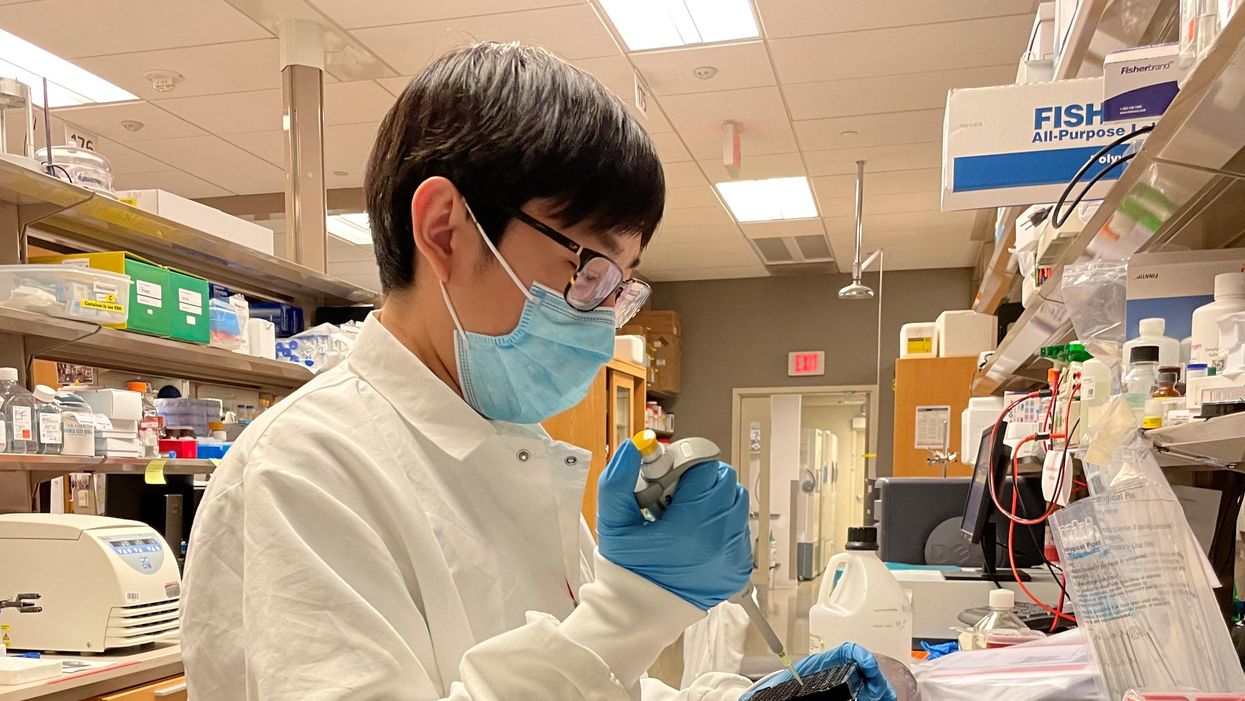Abortions Before Fetal Viability Are Legal: Might Science and the Change on the Supreme Court Undermine That?

The United States Supreme Court Building in Washington, D.C.
This article is part of the magazine, "The Future of Science In America: The Election Issue," co-published by LeapsMag, the Aspen Institute Science & Society Program, and GOOD.
Viability—the potential for a fetus to survive outside the womb—is a core dividing line in American law. For almost 50 years, the Supreme Court of the United States has struck down laws that ban all or most abortions, ruling that women's constitutional rights include choosing to end pregnancies before the point of viability. Once viability is reached, however, states have a "compelling interest" in protecting fetal life. At that point, states can choose to ban or significantly restrict later-term abortions provided states allow an exception to preserve the life or health of the mother.
This distinction between a fetus that could survive outside its mother's body, albeit with significant medical intervention, and one that could not, is at the heart of the court's landmark 1973 decision in Roe v. Wade. The framework of viability remains central to the country's abortion law today, even as some states have passed laws in the name of protecting women's health that significantly undermine Roe. Over the last 30 years, the Supreme Court has upheld these laws, which have the effect of restricting pre-viability abortion access, imposing mandatory waiting periods, requiring parental consent for minors, and placing restrictions on abortion providers.
Viability has always been a slippery notion on which to pin legal rights.
Today, the Guttmacher Institute reports that more than half of American women live in states whose laws are considered hostile to abortion, largely as a result of these intrusions on pre-viability abortion access. Nevertheless, the viability framework stands: while states can pass pre-viability abortion restrictions that (ostensibly) protect the health of the woman or that strike some kind a balance between women's rights and fetal life, it is only after viability that they can completely favor fetal life over the rights of the woman (with limited exceptions when the woman's life is threatened). As a result, judges have struck down certain states' so-called heartbeat laws, which tried to prohibit abortions after detection of a fetal heartbeat (as early as six weeks of pregnancy). Bans on abortion after 12 or 15 weeks' gestation have also been reversed.
Now, with a new Supreme Court Justice expected to be hostile to abortion rights, advances in the care of preterm babies and ongoing research on artificial wombs suggest that the point of viability is already sooner than many assume and could soon be moved radically earlier in gestation, potentially providing a legal basis for earlier and earlier abortion bans.
Viability has always been a slippery notion on which to pin legal rights. It represents an inherently variable and medically shifting moment in the pregnancy timeline that the Roe majority opinion declined to firmly define, noting instead that "[v]iability is usually placed at about seven months (28 weeks) but may occur earlier, even at 24 weeks." Even in 1977, this definition was an optimistic generalization. Every baby is different, and while some 28-week infants born the year Roe was decided did indeed live into adulthood, most died at or shortly after birth. The prognosis for infants born at 24 weeks was much worse.
Today, a baby born at 28 weeks' gestation can be expected to do much better, largely due to the development of surfactant treatment in the early 1990s to help ease the air into babies' lungs. Now, the majority of 24-week-old babies can survive, and several very premature babies, born just shy of 22 weeks' gestation, have lived into childhood. All this variability raises the question: Should the law take a very optimistic, if largely unrealistic, approach to defining viability and place it at 22 weeks, even though the overall survival rate for those preemies remains less than 10% today? Or should the law recognize that keeping a premature infant alive requires specialist care, meaning that actual viability differs not just pregnancy-to-pregnancy but also by healthcare facility and from country to country? A 24-week premature infant born in a rural area or in a developing nation may not be viable as a practical matter, while one born in a major U.S. city with access to state-of-the-art care has a greater than 70% chance of survival. Just as some extremely premature newborns survive, some full-term babies die before, during, or soon after birth, regardless of whether they have access to advanced medical care.
To be accurate, viability should be understood as pregnancy-specific and should take into account the healthcare resources available to that woman. But state laws can't capture this degree of variability by including gestation limits in their abortion laws. Instead, many draw a somewhat arbitrary line at 22, 24, or 28 weeks' gestation, regardless of the particulars of the pregnancy or the medical resources available in that state.
As variable and resource-dependent as viability is today, science may soon move that point even earlier. Ectogenesis is a term coined in 1923 for the growth of an organism outside the body. Long considered science fiction, this technology has made several key advances in the past few years, with scientists announcing in 2017 that they had successfully gestated premature lamb fetuses in an artificial womb for four weeks. Currently in development for use in human fetuses between 22 and 23 weeks' gestation, this technology will almost certainly seek to push viability earlier in pregnancy.
Ectogenesis and other improvements in managing preterm birth deserve to be celebrated, offering new hope to the parents of very premature infants. But in the U.S., and in other nations whose abortion laws are fixed to viability, these same advances also pose a threat to abortion access. Abortion opponents have long sought to move the cutoff for legal abortions, and it is not hard to imagine a state prohibiting all abortions after 18 or 20 weeks by arguing that medical advances render this stage "the new viability," regardless of whether that level of advanced care is available to women in that state. If ectogenesis advances further, the limit could be moved to keep pace.
The Centers for Disease Control and Prevention reports that over 90% of abortions in America are performed at or before 13 weeks, meaning that in the short term, only a small number women would be affected by shifting viability standards. Yet these women are in difficult situations and deserve care and consideration. Research has shown that women seeking later terminations often did not recognize that they were pregnant or had their dates quite wrong, while others report that they had trouble accessing a termination earlier in pregnancy, were afraid to tell their partner or parents, or only recently received a diagnosis of health problems with the fetus.
Shifts in viability over the past few decades have already affected these women, many of whom report struggling to find a provider willing to perform a termination at 18 or 20 weeks out of concern that the woman may have her dates wrong. Ever-earlier gestational limits would continue this chilling effect, making doctors leery of terminating a pregnancy that might be within 2–4 weeks of each new ban. Some states' existing gestational limits on abortion are also inconsistent with prenatal care, which includes genetic testing between 12 and 20 weeks' gestation, as well as an anatomy scan to check the fetus's organ development performed at approximately 20 weeks. If viability moves earlier, prenatal care will be further undermined.
Perhaps most importantly, earlier and earlier abortion bans are inconsistent with the rights and freedoms on which abortion access is based, including recognition of each woman's individual right to bodily integrity and decision-making authority over her own medical care. Those rights and freedoms become meaningless if abortion bans encroach into the weeks that women need to recognize they are pregnant, assess their options, seek medical advice, and access appropriate care. Fetal viability, with its shifting goalposts, isn't the best framework for abortion protection in light of advancing medical science.
Ideally, whether to have an abortion would be a decision that women make in consultation with their doctors, free of state interference. The vast majority of women already make this decision early in pregnancy; the few who come to the decision later do so because something has gone seriously wrong in their lives or with their pregnancies. If states insist on drawing lines based on historical measures of viability, at 24 or 26 or 28 weeks, they should stick with those gestational limits and admit that they no longer represent actual viability but correspond instead to some form of common morality about when the fetus has a protected, if not absolute, right to life. Women need a reasonable amount of time to make careful and informed decisions about whether to continue their pregnancies precisely because these decisions have a lasting impact on their bodies and their lives. To preserve that time, legislators and the courts should decouple abortion rights from ectogenesis and other advances in the care of extremely premature infants that move the point of viability ever earlier.
[Editor's Note: This article was updated after publication to reflect Amy Coney Barrett's confirmation. To read other articles in this special magazine issue, visit the e-reader version.]
Jacob Brenner and his partners at the University of Pennsylvania's Perelman School of Medicine are finding new ways to get nanomedicines to arrive at their targets.
Its strength is in its lack of size.
Using materials on the minuscule scale of nanometers (billionths of a meter), nanomedicines have the ability to provide treatment more precise than any other form of medicine. Under optimal circumstances, they can target specific cells and perform feats like altering the expression of proteins in tumors so that the tumors shrink.
Another appealing concept about nanomedicine is that treatment on a nano-scale, which is smaller yet than individual cells, can greatly decrease exposure to parts of the body outside the target area, thereby mitigating side effects.
But this young field's huge potential has met with an ongoing obstacle: the recipient's immune system tends to regard incoming nanomedicines as a threat and launches a complement protein attack. These complement proteins, which act together through a wave of reactions to get rid of troubling microorganisms, have had more than 500 million years to refine their craft, so they are highly effective.
Seeking to overcome a half-billion-year disadvantage, nanomaterials engineers have tried such strategies as creating so-called stealth nanoparticles.
“All new technologies face technical barriers, and it is the job of innovators to engineer solutions to them,” Brenner says.
Despite these clever attempts, nanomedicines largely keep failing to arrive at their intended destinations. According to the most comprehensive meta-analysis of nanomedicines in oncology, fewer than 1 percent of nanoparticles manage to reach their targets. The remaining 99-plus percent are expelled to the liver, spleen, or lungs – thereby squandering their therapeutic potential. Though these numbers seem discouraging, systems biologist Jacob Brenner remains undaunted. “All new technologies face technical barriers, and it is the job of innovators to engineer solutions to them,” he says.
Brenner and his fellow researchers at the Perelman School of Medicine at the University of Pennsylvania have recently devised a method that, in a study published in late 2021 involving sepsis-afflicted mice, saw a longer half-life of nanoparticles in the bloodstream. This effect is crucial because “the longer our nanoparticles circulate, the more time they have to reach their target organs,” says Brenner, the study's co-principal investigator. He works as a critical care physician at the Hospital of the University of Pennsylvania, where he also serves as an assistant professor of medicine.
The method used by Brenner's lab involves coating nanoparticles with natural suppressors that safeguard against a complement attack from the recipient's immune system. For this idea, he credits bacteria. “They are so much smarter than us,” he says.
Brenner points out that many species of bacteria have learned to coat themselves in a natural complement suppressor known as Factor H in order to protect against a complement attack.
Humans also have Factor H, along with an additional suppressor called Factor I, both of which flow through our blood. These natural suppressors “are recruited to the surface of our own cells to prevent complement [proteins] from attacking our own cells,” says Brenner.
Coating nanoparticles with a natural suppressor is a “very creative approach that can help tone and improve the activity of nanotechnology medicines inside the body,” says Avi Schroeder, an associate professor at Technion - Israel Institute of Technology, where he also serves as Head of the Targeted Drug Delivery and Personalized Medicine Group.
Schroeder explains that “being able to tone [down] the immune response to nanoparticles enhances their circulation time and improves their targeting capacity to diseased organs inside the body.” He adds how the approach taken by the Penn Med researchers “shows that tailoring the surface of the nanoparticles can help control the interactions the nanoparticles undergo in the body, allowing wider and more accurate therapeutic activity.”
Brenner says he and his research team are “working on the engineering details” to streamline the process. Such improvements could further subdue the complement protein attacks which for decades have proven the bane of nanomedical engineers.
Though these attacks have limited nanomedicine's effectiveness, the field has managed some noteworthy successes, such as the chemotherapy drugs Abraxane and Doxil, the first FDA-approved nanomedicine.
And amid the COVID-19 pandemic, nanomedicines became almost universally relevant with the vast circulation of the Moderna and Pfizer-BioNTech vaccines, both of which consist of lipid nanoparticles. “Without the nanoparticle, the mRNA would not enter the cells effectively and would not carry out the therapeutic goal,” Schroeder explains.
These vaccines, though, are “just the start of the potential transformation that nanomedicine will bring to the world,” says Brenner. He relates how nanomedicine is “joining forces with a number of other technological innovations,” such as cell therapies in which nanoparticles aim to reprogram T-cells to attack cancer.
With a similar degree of optimism, Schroeder says, “We will see further growing impact of nanotechnologies in the clinic, mainly by enabling gene therapy for treating and even curing diseases that were incurable in the past.”
Brenner says that in the next 10 to 15 years, “nanomedicine is likely to impact patients” contending with a “huge diversity” of conditions. “I can't wait to see how it plays out.”
Podcast: A Nasal Spray COVID Booster Shot, With Dr. Akiko Iwasaki
Dr. Akiko Iwasaki, an immunologist at Yale, is working on creating a nasal spray booster after the primary mRNA shots.
The "Making Sense of Science" podcast features interviews with leading medical and scientific experts about the latest developments and the big ethical and societal questions they raise. This monthly podcast is hosted by journalist Kira Peikoff, founding editor of the award-winning science outlet Leaps.org.
Real-world data shows that protection against Covid-19 infection wanes a few months after two or three shots of mRNA vaccines (while protection against severe disease remains high). But what if there was another kind of booster that could shore up the immune response in your nose, the "door" to your body? Like bouncers at a club, a better prepared nasal defense system could stop the virus in its tracks -- mitigating illnesses as well as community spread. Dr. Akiko Iwasaki, an immunologist at Yale, is working on such a booster, with fantastic results recently reported in mice. In this episode, she shares the details of this important work.
Listen to episode
Kira Peikoff was the editor-in-chief of Leaps.org from 2017 to 2021. As a journalist, her work has appeared in The New York Times, Newsweek, Nautilus, Popular Mechanics, The New York Academy of Sciences, and other outlets. She is also the author of four suspense novels that explore controversial issues arising from scientific innovation: Living Proof, No Time to Die, Die Again Tomorrow, and Mother Knows Best. Peikoff holds a B.A. in Journalism from New York University and an M.S. in Bioethics from Columbia University. She lives in New Jersey with her husband and two young sons. Follow her on Twitter @KiraPeikoff.

